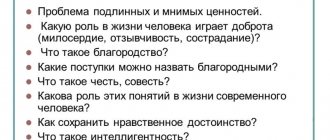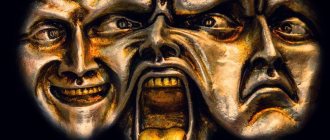Greetings, friends!
Throughout their lives, people develop connections with other members of society and their environment, constantly making sense of what they see and hear. By understanding and comprehending the world around them, people are able to harmoniously integrate into nature and society. In epistemology (the branch of philosophy that studies cognition), there are two types of cognition: rational and sensual. In this article you will learn what sensory cognition is, how it manifests itself, what stages it consists of, and what forms and types of sensory cognition exist. Let's start with the definition.
What is sensory knowledge?
Sensory cognition is a type of cognition based on the perception of the surrounding world using the senses. Traditionally, this type of cognition is opposed to thinking, which is a secondary method of cognition of reality. And the human senses are responsible for the formation of initial knowledge about the environment, as well as about the appearance and structure of the objects filling it. The five basic human senses are sight, hearing, taste, touch and smell.
Full knowledge of the world through the senses is inherent only in humans, although animals also use their senses to gain the necessary knowledge about the environment, but to a much lesser extent than people who are more biosocial by nature. At the same time, full knowledge of the world cannot be based solely on feelings; it is inseparable from rational thinking , without which a person will not be able to understand the essence of the phenomena and objects around him.
Methods of cognition
All methods of knowledge can be divided into two large groups (or two levels): empirical (based on direct observation of certain phenomena) and theoretical (based on the analysis of existing information and rational reasoning).
Empirical methods:
- observation - studying an object in its natural environment without any influence on ongoing processes;
- measurement – obtaining numerical characteristics of an observed object by comparing its properties with reference values;
- experiment - the deliberate creation of special conditions and further study of an object placed in these conditions;
- comparison - comparison of the properties of the object being studied with the properties of other objects that have already been studied previously.
Theoretical methods:
- analysis – dividing an object into components and detailed study;
- synthesis - recreating a complete picture from individual parts;
- comparison – comparison of several objects, identification of identical and different properties;
- classification - combining the objects under study into groups based on the presence of identical properties;
- specification - a deeper study of certain properties;
- abstraction - studying a subject from a new angle (with an emphasis on some properties and ignoring others);
- systematization - combining accumulated knowledge into a system in which relationships and patterns are clearly visible;
- induction – inferences directed from the particular to the general;
- deduction - inferences directed from the general to the specific;
- idealization - creating an image of a fictional object with ideal properties and using it as a standard;
- modeling - creating a model of an object for a detailed study of its properties, which is impossible on a real object.
Stages of sensory cognition
Modern science divides the cognitive process into several stages.
- The first stage of cognition is characterized by a kind of “imprinting” into the human psyche of knowledge about the appearance of various things;
- At the second stage, which is the comprehension of the surrounding reality, people form the necessary knowledge and judgments about it.
- The third stage includes the formation of stable and well-founded knowledge about the world around us, followed by a person’s interpretation of the feelings that initially arose in his mind.
Subject and object of knowledge. Cognition and Practice
Cognition is a special type of human activity aimed at understanding the world around us and ourselves in this world. An important feature of cognitive activity is its awareness. Cognition is a form of a person’s active relationship to reality. The subject and object of cognition are aspects of cognitive activity. To determine the essence of cognitive activity, it is necessary to turn to the content of the concepts “subject” and “object” of cognition.
The modern interpretation of the concept of “subject” was first presented by Descartes and is associated with the opposition of subject and object. In this case, the subject of cognition is considered as an active principle in the cognitive process. The object of cognition is what the subject’s cognitive activity is directed towards (in Kant’s terminology, the “thing in itself”). The subject of cognition can be an individual person, a group of researchers; in a sense, society acts as a subject of cognition in relation to nature. The object of knowledge is a very general concept that includes natural phenomena, other people with their consciousness, one’s own human body, and the products of one’s mental activity.
It is necessary to distinguish between the object and the subject of knowledge. Man as an object of study is common to a significant part of the natural and all social sciences. But the objects of knowledge in biology and medicine are the physical structure of a person, the physiological processes occurring in his body, and, to some extent, mental processes, as they relate to human health as a whole. In the social sciences, man as a social being is the subject of knowledge, and each of these sciences studies man, and therefore man, from a certain point of view.
The formation of a subject of cognition presupposes the formulation of the task of cognition, the choice of means and methods of cognition.
The development of the doctrine of the subject of knowledge brought with it the need to consider knowledge in close connection with practice. In the history of philosophy, the category of practice was developed for a long time outside the doctrine of knowledge. The connection between cognition and praxis received the most detailed development in Marxism. Marx characterized praxis as a specifically human, conscious, purposeful, material (sensual, subjective) activity of people to change the world.
Thus, although praxis is a material activity, it is an objective one in which the material and spiritual aspects form a unity. The spiritual moment of activity provides material activity, but it is not the leading side of practice. Practice is material due to its prerequisites, means and final results.
There are many types of practice, they include material production, social practice, which has a large number of its varieties. Social practice is the activity of establishing, reproducing and transforming social relations: economic, political, legal, moral, national, interstate, everyday, marriage and family, etc. A special type of practice is technical activity, which includes design as its elements and project activities (design) of people. Engineering activities are aimed at transforming various devices created by people, with the help of which the environment is changed. Currently, the relationship between various types of practice is changing significantly, and a more important place is occupied by its special type - scientific practice (scientific experiment).
Considering cognition in unity with practice helps explain why cognition is not an absolutely independent activity, but is a process determined by the needs of practice. It is the requirements of practice that stimulate cognitive activity. Cognition develops under the influence of the practical needs of social life and improves as social practice develops.
This position is illustrated by the fact that cognition is formed on the basis of all social activities of people.
It provides the cognitive process with the necessary factual material, which is systematized, generalized and processed, as well as with instruments and technical means.
Features of sensory cognition
The described type of cognition is based solely on perception and sensations, which allows us to identify several features that are characteristic only of it:
- knowledge of the world through feelings is the connecting link between man and the world of objects;
- this type of cognition is often referred to as “passive”;
- it is sensory cognition that is the main and most important element of cognition of culture, since information received by a person through the senses is perceived by him as unconditionally corresponding to reality;
- This type of cognition is capable of recording exclusively a “material”, objective picture of the world, information about which is provided to our brain by the senses. Therefore, in order to obtain a complete picture of objective reality, a person needs to bring his own cognitive activity to the next level - to the level of rational (from the Latin word ratio - i.e. reason) knowledge.
Forms of sensory knowledge
In sensory cognition, three levels are distinguished, the purpose of which is to prepare the individual for the transition to a higher stage of cognitive activity associated with abstraction. The main forms of this type of cognition include:
- Sensations, which are the initial level of cognition. This level of sensory cognition provides people with only an initial and one-sided understanding of objects, such as their appearance, smell, and taste.
- At the stage of perception, there is a certain accumulation of knowledge acquired by the individual earlier through sensations, which allows the person to form a fairly complete image of the object in his mind.
- At the final stage, representation, the images perceived from outside begin to be independently reproduced in the brain, creating a visual and meaningful picture of reality.
However, knowing the world through feelings is not capable of revealing the essence of phenomena occurring in the world - this level of cognitive activity is more complex, it requires the individual to use logic, analysis and rational thinking. Thus, only by combining living contemplation of the surrounding reality with abstract thinking will a person have the opportunity to fully understand the world around him.
Exercise
Establish the correspondence between mental processes and their characteristics:
a) Sensation
b) Perception
- as a result, an image of the object appears;
- as a result, a differentiated feeling arises;
- associated with the complex work of analyzers;
- associated with the operation of individual analyzers.
| 1 | 2 | 3 | 4 |
| b | A | b | A |
1. The image of an object is formed only by the totality of its characteristics, i.e. perception.
2. A differentiated feeling can arise when individual properties of an object are reflected, therefore, the correct answer is sensation.
3. The complex work of analyzers allows you to form an image of an object, which is the result of perception.
4. Individual analyzers can provide a characteristic of only a separate property of an object; this is the result of the sensation process.
Types of sensory cognition
The sensory type of cognition is based on the work of sensory analyzers and the human sensory system as a whole. Nowadays science identifies the following types of sensory perception:
- visual;
- auditory;
- tactile;
- taste;
- through smell;
- using the vestibular apparatus.
In addition, sometimes intuition is classified as a type of sensory cognition, losing sight of the fact that intuition does not start from logic and is not based on sensations. In essence, intuition can be attributed to a separate, very unique form of cognition, combining both rational and irrational principles.
Types of knowledge (scientific, creativity, self-knowledge)
It is customary to distinguish 7 types of knowledge:
- Ordinary involves the daily acquisition of basic information about the structure of the world. You can call it receiving life experience: living and understanding.
As a result, the individual understands what to do and what not to do, what is good and what is bad for him, masters ideas and builds cause-and-effect relationships that in the long term make his life better.This type of cognition is available to both adults and children. A child, playing in the sandbox, learns that if you pour sand on someone’s head, he will not be praised for it - he will also be punished. A housewife who accidentally adds an extra pinch of salt to a dish comes to the unexpected conclusion that it makes the food much tastier.
- Scientific knowledge is based on logic, studying cause-and-effect relationships.
Scientists put forward hypotheses (what is it?), which are confirmed or refuted during the research process. This type is also called rational, that is, based on common sense and objectivity. - Mythological - it was once an integral part of primitive society.
Ancient people did not bear any responsibility for anything, throwing it off to the forces of nature. For example, if a person fell from a cliff and died, it was not because the latter was careless and did not calculate his physical strength, but because he was taken by one of the divine beings, of which there were many invented at that time. It should be noted that in the modern world mythological knowledge also exists. It is adhered to mainly by those who are far from science or those who, due to their psychological characteristics, do not want to be responsible for their actions and mystify life events (especially negative ones). - Religious - aimed at studying relationships with God. It is interesting that the latter here plays the role of both subject and object. Religious consciousness perceives reality as God's providence, aimed at good thoughts and actions, and is in anticipation of feedback from above.
- Artistic knowledge and creativity is a way of reflecting reality through symbols and images.
It is limitless and cannot be analyzed or proven. It is a product of mental activity based on the ideas of the creator. For example, futuristic paintings, as a reflection of the artist’s inner world, contain illogical, inexplicable images that cannot be subjected to scientific research, however, they have every right to exist. - Philosophical knowledge is concerned with defining the role of man, searching for the meaning of life through the prism of the categories of good and evil. Philosophy tries to study the essence of human existence and answer “eternal” questions regarding existence. Who are we, why do we live, why was the world created, what is truth, etc.
- Self-knowledge is the study of one’s own states: moods, thoughts, thoughts and actions. This is an analysis of one’s personality, leading to an awareness of one’s needs, goals and motives, which helps a person to be confident in himself and his abilities, not to depend on the crowd and its stereotypes.
The meaning of sensory knowledge
The appearance in the consciousness of a visual, sensory image is preceded by a certain impact on the senses, and through them - on the human nervous system of a certain object of the material world, acting as an external stimulus. But mere influence on the senses is not enough for the emergence of a comprehensive image, since any cognition requires at least minimal activity. And therefore, the senses must actively participate in the exploration of a new thing through straining vision, hearing and smell, feeling the contours of an unknown object, etc.
The sensory type of cognition refers to the primary sources of a person’s acquaintance with the outside world. As mentioned above, full-fledged cognition is closely related to thinking and the creation in the brain of rationally and logically based images that complement the picture of the world provided to people by their senses.
A sensory image reflecting a material object is not a symbol of this object, but only represents its exact copy, generated by one or more sense organs. This image also has objective and subjective sides - it is objective in terms of its own content and subjective, since it exists as a visual image in the mind of a particular individual , created on the basis of his perception of the surrounding reality. In addition, sensory knowledge also has certain boundaries, which a person can go beyond only with the help of rational thinking.
The essence
A person has several sense organs: eyes, nose, tongue, skin and ears. These sense organs are responsible for comprehending the world and allow us to interact with it in the following ways:
Vision, or visual perception, allows a person to see the surrounding reality. Vision is the basis for images of an existing object, which then emerge in the human mind.
Hearing is the perception of sound. Sound vibrations through the ears enter the brain, which determines what we hear: the sound of the surf, or the singing of birds, or maybe the words spoken by another person?
Touch - or tactile perception. We can feel surrounding objects by touching them. For example, you can pet a cat and realize that it is soft and fluffy.
The sense of smell is smells. Smells also form images. For example, you go home after school, hungry, and when you go up the stairs, you smell the delicious smell of chicken and potatoes. And in your mind the image of a large dish with roasted chicken and potatoes immediately appears, next to it there is cold kvass and chopped onions... Mmm! But this is just an image created by your sense of smell and the power of your mind.
Taste. Language allows us to taste things. This is why small children put everything in their mouth - they want to perceive the object with all their senses - this is instinct.
The connection between rational and sensory cognition
So, the sensory type of cognition has its own boundaries, outlined, on the one hand, by the nature and physiology of man, on the other hand, by the openness and suitability of sensory cognition only for studying the external aspects of objects, but by the impossibility of studying with its help the patterns associated with their emergence and development . For a deeper knowledge of the world, feelings must always be supplemented by logic and rational thinking.
The rational type of cognition differs from the sensory type in that it is more general and indirect in the process of studying the environment. It is based on abstraction and generalization, which allows a person operating with this method of cognition to derive clear and understandable general patterns.
For this reason, rational knowledge helps a person to explore much deeper and more fully not only the external, but also the deep essence of the environment, form his own judgments and make independent, logically sound conclusions about what is happening around him. At the same time, rational knowledge complements and improves the knowledge acquired by man through the senses, acting as a factor in the development and transformation of the world.
Both ways of cognition (sensual and rational) are inseparable from each other. Despite significant differences, they are two closely interconnected sides of a single process, the development of which is possible only with their mutual complement.
Rational knowledge and its forms
Now let’s briefly look at the features of rational cognition. This form of research into this world differs from instinctive perception in that it is based on logical thinking and accumulation of knowledge.
An abstract train of thought helps us go beyond sensory knowledge and make important decisions.
Rational cognition includes three methods of touch:
- Concept
characterized by the ability to create a collective concept about a particular subject. For example, the concept of “notebook” will have a general concept and a set of specific characteristics for a person that do not depend on time or location.
- Judgment
is a special form of cognition that is capable of summing up the number of available concepts and forming one’s own judgment about the environment. This also includes the relationship between life events and circumstances on the basis of which a person draws certain conclusions. For example, to conclude what psychology is, it will not be enough for us to read one rule in a textbook. To do this, you need to learn a lot of concepts from psychology and study the topic in depth in order to finally form your own subjective opinion.
- Inference
, in turn, is based on a set of judgments and helps us find the truth. To form a final opinion, it is not enough to collect a certain number of concepts. To do this, by collecting judgments, you need to make a single conclusion that will be true for a person.
In a word, rational knowledge is a reasonable approach to a particular issue. To successfully use this type of touch, you need to be good at logic and abstract thinking. To do this, it is necessary to increase your level of operating judgments, concepts and conclusions.
conclusions
In the recent past, scientists attributed sensory cognition to the lowest level of human thinking. This conclusion was justified by the fact that an individual who knows the world only through feelings is guided exclusively by instincts. But modern philosophy looks at the sensory type of cognition from a different angle, linking together both sensory and rational methods of studying the surrounding reality, and also recognizing feelings as a kind of foundation for more detailed and logic-based cognitive activity.
Introduction
One of the most important definitions of epistemology is that cognition is a complex, contradictory process. The difficulty lies in the fact that cognition is multi-level, multi-dimensional, determined by various causes and conditions, and unfolds in space and time. The contradictory nature of knowledge is already manifested in the fact that it turns the material into its opposite - the ideal. In the process of reflection, the physical (the external world, its real properties and relationships) is transformed into the physiological (the activity of the nervous system and brain), and, finally, into the mental - into a fact of consciousness, mental images of things, events, processes. The contradictory nature of knowledge is also revealed in the specificity of its forms, in the nature of the connections of these forms with each other.
The purpose of knowledge is knowledge. It is necessary for: a person’s orientation in the world around him; explanations and predictions of events; planning and execution of activities. Knowledge is a means of transforming reality, and it is a system. Knowledge appears in the process of cognition, and it consists of forms, stages, levels. As a rule, epistemology distinguishes between sensory and rational cognition, and also considers intuition as a special moment in the connection of sensory and rational cognition.










